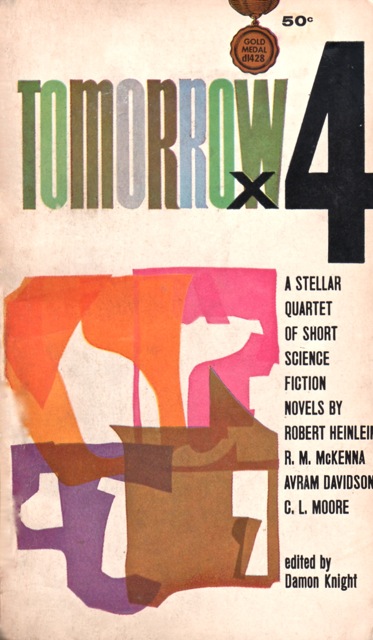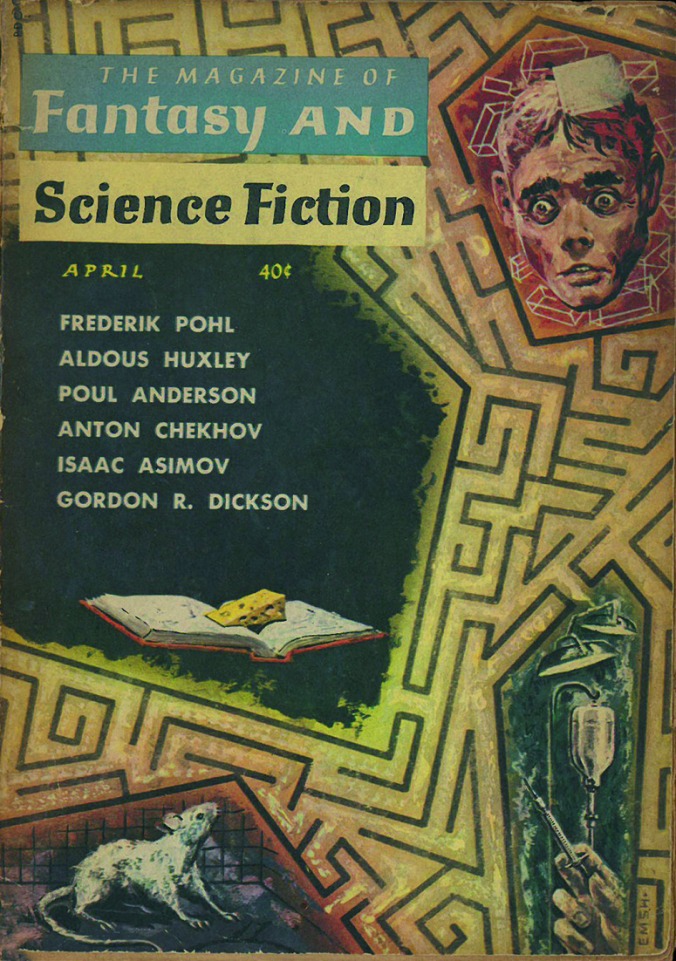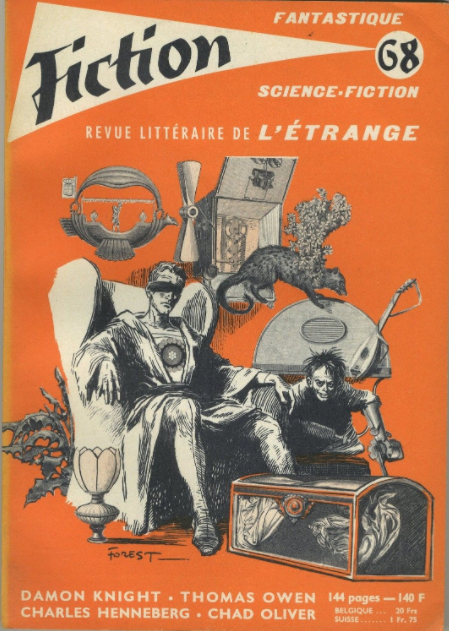The scholarly and widely published Kate Macdonald (twitter), a Professor of English Literature and currently a Visiting Fellow at the University of Reading, provides the fifth guest post in my SF Short Stories by Women Writers pre-1969 series (original announcement and list of earlier posts). I recommend browsing her eponymous blog—she recently interviewed the SF author Elizabeth Moon on her collaborations with Anne MacCaffrey and reviews literature and SF (including Iraq + 100. Stories from a Century After the Invasion (2013), ed. Hassan Blasim and the famous post-apocalyptical novel The Long Tomorrow (1955) by Leigh Brackett).
Her post focuses on two of the best known SF women authors from the pre-1969 era: C.L. Moore and Anne McCaffrey.
Cyborgs! Intergalactic Freight Spaceships!
Find copies!
_________________________________________________________________

(“No Woman Born” first appeared in Astounding Science Fiction, December 1944, cover: William Timmins)
Review of “No Woman Born” (1944) by C.L. Moore and “Lady in the Tower” (1959) by Anne McCaffrey
By Kate Macdonald
I teach sf to university students, and knew from the critical literature about gender in sf that sometime in the 1940s a writer called C. L. Moore published a landmark story about the first female cyborg. I tracked down a copy of ‘No Woman Born’ this year, and was deeply impressed. This story is a glowing beacon of fine writing and an impressive acceleration of how the cyborg operates in fiction. No longer a destructive masculine, war-making automaton from the post-WW1 years, this cyborg is a dancer and singer whose new flexibility and vocal range enhance her art, and successfully disguise her strength of purpose by using her femininity to cloak her developing ambitions. Deirdre is a person who is now a cyborg, and her humanity is totally present throughout this novella, despite her gleaming gold body, and her inhuman speed and agility.
The story could just as well be a three-act play. It’s set in Deirdre’s apartment where Harris, her former manager, comes to visit her for the first time after her rehabilitation following a disastrous fire, then when he and her besotted surgeon Maltzer watch her first public performance on TV in her new body, and finally when Harris witnesses Maltzer’s threat to prevent any more cyborgs being made, and Deirdre’s command. ‘No Woman Born’ is not just a story of one person, it’s an opening up of possibilities: cyborgs are stronger and faster, so what will that mean for women, as well as for men? What will that mean for the humans left behind? Can relations between a man and a woman be the same now that the woman is made of metal? How will a woman feel about her body, when no-one is there to admire it? And does this matter? By creating a female cyborg whose primary attributes, in the eyes of the men who managed and created her, are her grace and beauty, Moore shows us that when a cyborg claims autonomy, she becomes nobody’s creature, and can decide how she will live her extended, augmented life. It is a tremendous, game-changing story for feminism in sf, and for how we need to learn to think about being post-human. It’s also beautifully written, with unforgettable images of Deirdre learning to see, to stand, move and dance humanly again, in her glittering robe of metal mesh, and her golden, visored face.
(“No Woman Born” was frequently anthologized, here Tomorrow X 4 (1964), cover: Uncredited)
(“No Woman Born” appeared in The Best of C. L. Moore (1975), cover: Chet Jezierski)
Anne McCaffrey, “Lady in the Tower” (1959)
‘Lady in the Tower’ is one of Anne McCaffrey’s first published stories, and belongs to the body of work that was overshadowed by her dragon novels, the world of the Talent (To Ride Pegasus, 1973, Pegasus in Flight, 1990, and Pegasus in Space, 2000), which logically precedes her stories and novels of The Tower and the Hive (The Rowan, 1990, Damia, 1991, and three more, but much less good novels, and a cat-fanciers’ spin-off series about space cats). This world of telekinesis as a perfectly normal part of developing humanity began with ‘The Lady in the Tower’, and captured my imagination permanently when I first read it as a teenager in McCaffrey’s endearingly titled anthology Get Off the Unicorn (1979).
(“Lady in the Tower” first appeared in The Magazine of Fantasy and Science Fiction, April 1959, cover: Ed Emshwiller)
It’s about The Rowan, an intergalactic freight transporter working on Callisto Station in her professional capacity with her phenomenal powers of telekinesis to move ships, payloads and people around the galaxy. When she‘s in a good mood she teleports people to their home planets for the weekend as a treat; when she’s in a towering rage of frustration and loneliness all her colleagues keep their heads down and their minds firmly on the job. The Rowan is agoraphobic, and the only Talent in her class, so there is no-one in the galaxy as mind-powerful as she is, and no-one so trapped on one lump of rock, since she can’t tolerate space flight, or teleport herself. Until she hears a distant voice in her mind asking her to get a move on with the urgent medical shipment to his system because people are dying from exoplanet germ attacks, and he needs the antiviral kits immediately. Aggravated by his challenging attitude, The Rowan pushes herself to new and unknown capacities, which is a jolly good thing all round. ‘The Lady in the Tower’ is space opera, but in its most interesting form, because it’s about the daily working lives of people with extraordinary powers, and how they sort out being human as well as being special. It’s one of McCaffrey’s strongest stories because she was writing straight from the idea, all white-hot and glowing with energy.
(“The Lady in the Tower” was collected in Get off the Unicorn (1977), cover: David Roe)
(“The Lady in the Tower” was translated into French in Fiction, #68 (1969), ed. Alain Dorémieux, cover: Jean-Claude Forest)
For more book reviews consult the INDEX





Pingback: Pixel Scroll 12/18/16 Scroll Measured By Weight. Pixels May Settle In Packing | File 770
Thank you Kate for the wonderful review. I need to find copies of both….
I adored McCaffrey’s Pern novels as a kid, read many of them three or four times. However, I don’t think I’ve read any of her pre-Pern SF!
Does Moore’s short story come up frequently in scholarly discussion of posthumanism in SF?
Both of these sound quite wonderful – thank you for sharing them with us! I shall be checking them out, particularly the Moore one.
I was quite impressed with McCaffrey’s story. A great first effort. Thank you for your review!
Pingback: A little recap: C L Moore and Anne McCaffrey – Kate Macdonald